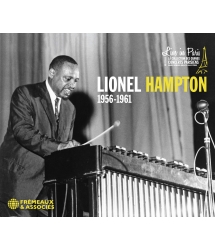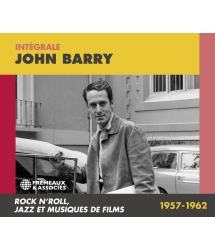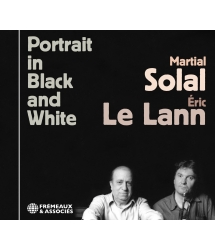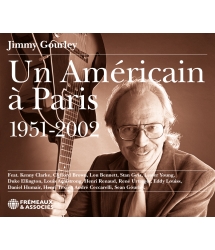- Notre Catalogue
- Philosophie
- Philosophes du XXème siècle et d'aujourd'hui
- Histoire de la philosophie (PUF)
- Contre-Histoire et Brève encyclopédie par Michel Onfray
- L'œuvre philosophique expliquée par Luc Ferry
- La pensée antique
- Les penseurs d'hier vus par les philosophes d'aujourd'hui
- Textes philosophiques historiques interprétés par de grands comédiens
- Histoire
- Livres
- Sciences Humaines
- Paroles historiques
- Livres audio & Littérature
- Notre Catalogue
- Jazz
- Blues - R'n'B - Soul - Gospel
- Rock - Country - Cajun
- Chanson française
- Musiques du monde
- Afrique
- France
- Québec / Canada
- Hawaï
- Antilles
- Caraïbes
- Cuba & Afro-cubain
- Mexique
- Amérique du Sud
- Tango
- Brésil
- Tzigane / Gypsy
- Fado / Portugal
- Flamenco / Espagne
- Yiddish / Israël
- Chine
- Tibet / Népal
- Asie
- Océan indien / Madagascar
- Japon
- Indonésie
- Océanie
- Inde
- Bangladesh
- URSS / Chants communistes
- Musiques du monde / Divers
- Musique classique
- Compositeurs - Musiques de film - B.O.
- Sons de la nature
- Notre Catalogue
- Jeunesse
- Philosophie
- Nouveautés
- Comment commander ?
- Recevoir le catalogue
- Manifeste
- Dictionnaire











- Notre Catalogue
- Philosophie
- Philosophes du XXème siècle et d'aujourd'hui
- Histoire de la philosophie (PUF)
- Contre-Histoire et Brève encyclopédie par Michel Onfray
- L'œuvre philosophique expliquée par Luc Ferry
- La pensée antique
- Les penseurs d'hier vus par les philosophes d'aujourd'hui
- Textes philosophiques historiques interprétés par de grands comédiens
- Histoire
- Livres
- Sciences Humaines
- Paroles historiques
- Livres audio & Littérature
- Notre Catalogue
- Jazz
- Blues - R'n'B - Soul - Gospel
- Rock - Country - Cajun
- Chanson française
- Musiques du monde
- Afrique
- France
- Québec / Canada
- Hawaï
- Antilles
- Caraïbes
- Cuba & Afro-cubain
- Mexique
- Amérique du Sud
- Tango
- Brésil
- Tzigane / Gypsy
- Fado / Portugal
- Flamenco / Espagne
- Yiddish / Israël
- Chine
- Tibet / Népal
- Asie
- Océan indien / Madagascar
- Japon
- Indonésie
- Océanie
- Inde
- Bangladesh
- URSS / Chants communistes
- Musiques du monde / Divers
- Musique classique
- Compositeurs - Musiques de film - B.O.
- Sons de la nature
- Notre Catalogue
- Jeunesse
- Philosophie
- Nouveautés
- Comment commander ?
- Recevoir le catalogue
- Manifeste
- Dictionnaire
LIVE IN PARIS - 1960-1962
GERRY MULLIGAN
Ref.: FA5796
EAN : 3561302579627
Label : Frémeaux & Associés
Durée totale de l'œuvre : 2 heures 59 minutes
Nbre. CD : 3
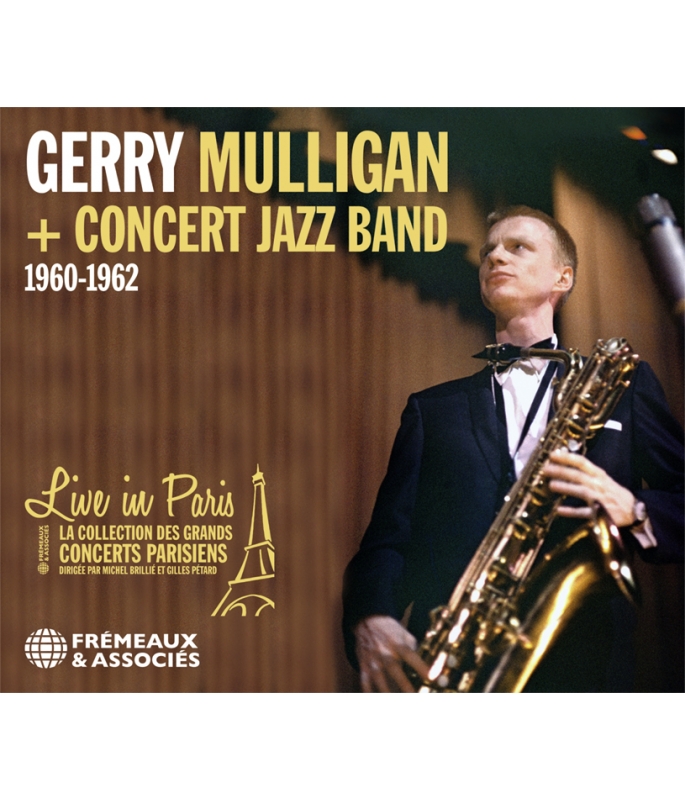
LIVE IN PARIS - 1960-1962
Gerry Mulligan est sans doute le plus grand saxophoniste baryton de l’histoire du jazz, formidable instrumentiste et arrangeur, il incarne à lui tout seul la sommité du cool jazz. Ce coffret 3 CD regroupe des enregistrements captés à Paris de sa célèbre formation big band : le Concert Jazz Band, dans laquelle s’illustrent notamment Zoot Sims et Bob Brookmeyer. La quintessence du jazz orchestral.
Patrick FRÉMEAUX
La collection Live in Paris, dirigée par Michel Brillié, permet de retrouver des enregistrements inédits (concerts, sessions privées ou radiophoniques), des grandes vedettes du jazz, du rock & roll et de la chanson du XXe siècle. Ces prises de son live, et la relation avec le public, apportent un supplément d’âme et une sensibilité en contrepoint de la rigueur appliquée lors des enregistrements studios. Une importance singulière a été apportée à la restauration sonore des bandes, pour convenir aux standards CD tout en conservant la couleur d’époque.
Patrick FRÉMEAUX & Gilles PÉTARD
No doubt the greatest baritone player in jazz history, saxophonist Gerry Mulligan was a wonderful composer and arranger who came to represent the summits of cool jazz all on his own. This 3CD set brings together recordings he made in Paris with the famous jazz group he called his Concert Jazz Band, which also featured notably the tenor Zoot Sims and trombonist Bob Brookmeyer. The quintessential jazz orchestra.
Patrick FRÉMEAUX
The Live in Paris collection by Michel Brillié allows listeners to hear previously-unreleased recordings (made at concerts and private- or radio-sessions) by the great 20th stars in jazz, rock & roll and song. These “live” takes, and the artists’ rapport with their audiences, gives these performances an additional soul and sensibility in counterpoint to the rigorous demands of studio recordings. Particular care was taken when restoring the sound of these tapes in order to meet CD standards while preserving the original colours of the period.
Patrick FRÉMEAUX & Gilles PÉTARD
CD1 : UTTER CHAOS • BAND INTRODUCTION • YOU TOOK ADVANTAGE OF ME (1ST CONCERT) • EIGHTEEN CARROTS FOR RABBIT • DARN THAT DREAM • YOU TOOK ADVANTAGE OF ME (2ND CONCERT) • BLACK NIGHTGOWN • BODY AND SOUL • BARBARA’S THEME • APPLE CORE • COME RAIN OR COME SHINE • OUT OF THIS WORLD • SPRING IS SPRUNG.
CD2 : MY FUNNY VALENTINE • I’M GONNA GO FISHIN’ • BROADWAY • BWEEBIDA BOBBIDA • GO HOME • BLUE PORT • UTTER CHAOS.
CD3 : SPRING IS SPRUNG • FIVE BROTHERS • SUBTERRANEAN BLUES • DARN THAT DREAM • BLUEPORT • UTTER CHAOS.
DIRECTION ARTISTIQUE : GILLES PÉTARD ET MICHEL BRILLIÉ - LIVRET : MICHEL BRILLIÉ
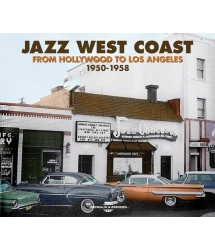
FROM HOLLYWOOD TO LOS ANGELES 1950 - 1958
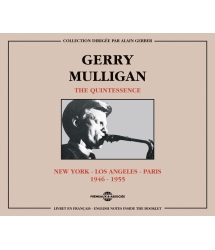
NEW YORK LOS ANGELES PARIS 1946-1955
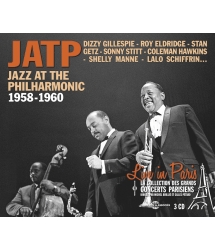
1958-1960
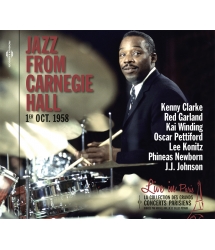
KENNY CLARKE, RED GARLAND, KAI WINDING, OSCAR...




-
PisteTitreArtiste principalAuteurDuréeEnregistré en
-
1Utter ChaosGerry MulliganGerry Mulligan00:01:331960
-
2Band IntroductionGerry MulliganGerry Mulligan00:01:171960
-
3You Took Advantage Of MeGerry MulliganLorenz Hart00:04:411960
-
4Eighteen Carrots For RabbitGerry MulliganGerry Mulligan00:07:281960
-
5Darn That DreamGerry MulliganEddie Delange00:07:461960
-
6You Took Advantage Of Me 2Gerry MulliganLorenz Hart00:04:261960
-
7Black NightgownGerry MulliganJohnny Mandel00:03:571960
-
8Body And SoulGerry MulliganEdward Heyman00:05:371960
-
9Barbara's ThemeGerry MulliganJohnny Mandel00:05:411960
-
10Apple CoreGerry MulliganGerry Mulligan00:04:571960
-
11Come Rain Or Come ShineGerry MulliganJohnny Mercer00:04:151960
-
12Out Of This WorldGerry MulliganJohnny Mercer00:03:451960
-
13Spring In SprungGerry MulliganGerry Mulligan00:21:351960
-
PisteTitreArtiste principalAuteurDuréeEnregistré en
-
1My Funny ValentineGerry MulliganLorenz Hart00:05:301960
-
2I'M Gonna Go Fishin'Gerry MulliganPeggy Lee00:07:211960
-
3BroadwayGerry MulliganBilly Byrd00:13:381960
-
4Bweebida BobbidaGerry MulliganGerry Mulligan00:08:071960
-
5Go HomeGerry MulliganBen Webster00:09:471960
-
6Blue PortGerry MulliganArt Farmer00:10:481960
-
7Utter Chaos 2Gerry MulliganGerry Mulligan00:01:571960
-
PisteTitreArtiste principalAuteurDuréeEnregistré en
-
1Spring Is Sprung 2Gerry MulliganGerry Mulligan00:08:551962
-
2Five BrothersGerry MulliganGerry Mulligan00:06:041962
-
3Subterranean BluesGerry MulliganGerry Mulligan00:11:221962
-
4Darn That Dream 2Gerry MulliganEddie Delange00:07:431962
-
5BlueportGerry MulliganGerry Mulligan00:10:061962
-
6Utter Chaos 3Gerry MulliganGerry Mulligan00:01:121962
GERRY MULLIGAN
+ CONCERT JAZZ BAND
1960-1962
Sur les pas de Jeru
Soulevez un sax baryton : ça pèse six kilos. « C’est de la grosse plomberie… C’est comme faire de la musique avec l’évier de la cuisine ! » Il est vrai que beaucoup de jeunes musiciens ont été découragés par le poids de l’instrument. Pourquoi alors Gerry Mulligan a-t-il fait du baryton son instrument de prédilection ? Pourtant, à ses débuts, Mulligan a hésité entre le piano, tâté du ténor, de la clarinette, de la trompette… Puis, alors qu’il est dans la formation de Gene Krupa, il décide de vendre tout son attirail et de ne garder que le baryton. « Je n’ai jamais analysé pourquoi j’ai choisi le baryton » explique-t-il dans une interview au Chicago Tribune, « Pas plus que je n’analyse ce qui m’a poussé à composer. Je devais le faire. Je n’avais pas le choix. »
C’est la même impulsion qui pousse le jeune Gerald, élève de 16 ans au collège catholique de West Philadelphia, à aborder James Warrington, le leader d’un grand orchestre local de trente musiciens, et à lui proposer ses services d’arrangeur-compositeur.
Deux ans plus tard, en 1946, à 18 ans, il écrit de nouveaux arrangements, cette fois-ci pour le big band du batteur Gene Krupa. Pendant six ans, il a continué d’arranger pour Krupa, et puis aussi pour les ensembles de Claude Thornhill, Elliot Lawrence ou Stan Kenton. Mais sa célébrité mondiale sera due à une formation à l’extrême opposé d’un big band. En été 1952, avec le trompettiste Chet Baker, Mulligan forme le pianoless quartet, un groupe qui se passe de pianiste.
A la fin des années quarante, la cohésion des sons travaille toujours « Jeru », le petit nom que Miles Davis a donné à Mulligan. Tous deux sont collègues de pupitre dans l’orchestre de Claude Thornhill. Bien naturellement, quand Mulligan se retrouve dans l’appartement de Gil Evans pour jeter les bases du célèbre nonette de l’enregistrement de Birth of the Cool, Miles n’est pas loin. Les talents d’arrangeur de Mulligan sont évidents dans cet album mythique, pour lequel il va orchestrer la moitié des morceaux, et en composer trois. On a peut-être souvent minimisé sa participation au profit de Gil Evans, mais la patte de Mulligan est bien là : « Alléger, alléger... C’est le grand secret quand on veut fabriquer du naturel. Un arrangement consiste à dire le plus clairement et le plus simplement du monde ce qu’on veut dire. Dizzy Gillespie disait que ce qui compte le plus n’est pas ce que vous mettez dans un arrangement, c’est ce que vous décidez de ne pas y laisser. »
Big Band Theory
En fait, quand Gerry Mulligan a lancé son Concert Jazz Band au printemps 1960, c’était comme des retrouvailles avec un vieux flirt, ce souffle élégant du nonette.
« J’ai toujours voulu avoir un big band, et cet ensemble est issu de l’évolution de mes petites formations. Mais si certains de mes amis n’avaient pas insisté, ça n’aurait sans doute jamais vu le jour. Je voulais quelque chose de léger, comme les formations des années 30, plus agiles, moins pesantes. J’avais en tête de faire quelque chose qui me rappelle l’instrumentation de Birth of the Cool. »
Au début de l’année 60, Mulligan a été engagé pour une semaine de concert au « Basin Street East », le club de jazz de New York. Pour l’occasion, il a décidé de monter son big band. Quelque chose de réduit, trois trompettes, trois trombones (y compris le trombone à valve de Brookmeyer), quatre anches, une basse et une batterie. Avec son propre saxophone baryton, cela faisait un groupe de 13 musiciens. Toujours sans piano, même si parfois Mulligan, ou Brookmeyer se mettaient au clavier.
« Tout cela faisait partie d’un mouvement général pour faire des choses plus évidentes avec le contrepoint. Chacune des lignes des instruments avait sa propre fonction au sein de l’ensemble, jouant des lignes séparées. C’est ça, le contrepoint »
Les arrangements ont été écrits en groupe, avec Bob Brookmeyer et Al Cohn. Mulligan y adjoint Bill Hollman, un ténor venu de Californie. Johnny Mandel, qui vient de collaborer avec Gerry Mulligan sur la musique du film « I Want to Live » est aussi de la partie. Trop accaparé par sa fonction de band leader, Mulligan n’a pas pu écrire autant qu’il l’aurait voulu. Il l’admet volontiers : « Oui j’ai mis mon empreinte sur le CJB, et j’en suis l’un des solistes vedettes, mais je fais plus de supervision que de contribution »
Le résultat final, selon le bassiste Bill Crow, sonnait comme un délicat mélange de couleurs différentes, « comme si l’on tissait une tapisserie… Proche, d’un côté, de Claude Thornhill, de l’autre, Debussy ou Ravel. »
Cette intrication des parties musicales va créer une émulation exceptionnelle et rare chez les membres du groupe. Plus de 50 ans après, Bill Hollman en a gardé un souvenir vif :
« Quand on jouait, on pouvait sentir l’enthousiasme des mecs sur scène. Ce n’était pas du boulot, mais du plaisir. Ils se posaient tous des questions sur la manière d’améliorer le son, ce qui est rare dans les grands orchestres. Il y avait beaucoup de respect dans le groupe. Ca restera un moment unique. »
La dream team de Granz
Et revoici Norman Granz. L’agent des plus grandes vedettes du jazz a déjà produit des choses intéressantes avec Mulligan : par exemple, il l’a tout simplement accoquiné avec Stan Getz, pour l’album Getz Meets Mulligan in Hifi. Granz a contacté Mulligan après la semaine au Basin Street East. Toujours en quête de nouveautés, il a alors décidé de monter la toute première tournée du Concert Jazz Band, là où le jazz a droit de cité : en Europe. Mais auparavant, petite mise en train aux USA, à Santa Monica et au festival de jazz de Newport. Mulligan : « Granz estimait qu’il était important de rôder l’orchestre aux Etats Unis, où tout le monde s’en fichait, avant d’aller en Europe, où le public était impatient de nous entendre. Il y a eu vraiment un énorme enthousiasme, une formidable exaltation sur le vieux continent. »
Le planning de la tournée de Novembre 1960 est bouclé rapidement : Göteborg, Berlin, Milan, Bâle, Copenhague, Gênes, puis Paris et Stockholm.
«Quand on est allé en Europe, je nous avais surnommé « l’équipe itinérante de basket-ball », se souvient Bob Brookmeyer. « Mais il y avait beaucoup d’esprit de corps dans le groupe, et nous avons vraiment aimé jouer ensemble, et nous étions, je pense, fiers du groupe aussi. »
A Paris, l’ensemble des 13 types, augmenté de Zoot Sims, prend place sur la scène de l’Olympia. « Sagement alignés derrière leurs pupitres, vêtus d’un noir strict, les cheveux en brosse, et chaussant pour la plupart des lunettes à grosse monture d’écaille, les Douze installaient au cœur de Paris cette Amérique universitaire… » En ce samedi de mi-novembre 1960, l’équipe de Mulligan assure par deux fois, à 18h et minuit, selon l’accord passé entre Bruno Coquatrix, Daniel Filipacchi et Frank Ténot, pour permettre à la vedette du moment du music-hall de se produire à 21h. Sur le CD1 de ce coffret sont réunis les premiers morceaux encore inédits du premier concert (jusqu’à « Darn That Dream » inclus) que l’équipe de Live in Paris vient de retrouver dans les archives de Michel Poulain, l’un des deux principaux collaborateurs de l’émission « Pour ceux qui aiment le jazz ». Suit la quasi-intégralité du second concert, « un travail d’art ciselé par les doigts d’un orfèvre ».
De retour aux USA, Norman Granz fait le point avec Mulligan et les membres du CJB. L’agent propose un deal : il va couvrir les pertes des prestations américaines, en se rattrapant sur les gains de la tournée en Europe. A l’occasion de cette réunion avec tous les musiciens, l’agent leur demande de chiffrer chacun le salaire qui leur permettrait de subsister. « Tout le monde a donné le chiffre le plus bas possible, pour pouvoir continuer avec ce big band, » se souvient le bassiste Bill Crow.
Début 1961, quand Granz a vendu Verve à MGM, l’arrangement financier avec Mulligan s’en est trouvé caduque. Mulligan n’avait plus qu’un concert prévu un mois plus tard à Boston. « Je n’ai plus les moyens de cet orchestre », a-t-il dit, et il a dissous le Concert Jazz Band. L’orchestre s’est néanmoins reformé ici et là jusqu’en 1964, et enregistrera cinq albums chez Verve.
Enfin, en 2006, dix ans après la mort de Mulligan, le saxophoniste Ted Hogarth, grand admirateur des orchestrations du Concert Jazz Band, a contacté Franca Mulligan, la veuve du musicien, pour pouvoir réutiliser les partitions de l’ensemble. Avec la formation de son « Mulligan Mosaics Big Band », le flambeau du CJB a été repris.
Le compagnon de Jeru
Quelques décennies auparavant, l’un des porteurs de la flamme du Concert Jazz Band a surement été Bill Crow. Crow est un vieux routier pour Mulligan : dès le début des années cinquante, il a été l’un des sidemen du baryton, en particulier dans son quartet avec Art Farmer, qui a remplacé Bob Brookmeyer pendant un temps.
Dans son livre From Birdland to Broadway, Crow a gardé un souvenir précis de toutes les sessions avec Mulligan, de répétitions en plein air dans Central Park par manque de fonds, puis du tout premier voyage en Europe avec le sextette formé par Mulligan en janvier 56.
Les six musiciens – parmi lesquels Zoot Sims et Bob Brookmeyer- sont passés pour une vingtaine de jours par Paris, où ils ont été hébergés dans une petite pension de famille près de l’Olympia. Dans le programme du music-hall du boulevard des Capucines, Ils ont partagé l’affiche avec des jongleurs, avec les Nicolas Brothers, célèbres pour leur numéro de claquettes, et avec la chanteuse Jacqueline François. Pendant cette prestation, « l’équipe de basket » de Mulligan a corsé un peu les choses... Chaque soir, la présentatrice de l’Olympia faisait l’introduction des divers artistes. Le premier soir, elle les a bien présentés avec un retentissant « et maintenant, Zéri Mouligane et son sextette ! » Mais les jours suivants, la troupe de Mulligan s’est un peu étiolée… La bande disposait de beaucoup de temps libre pour visiter Paris, et régulièrement, l’un des musiciens était absent au moment du spectacle. Prudente, la jeune présentatrice s’est bien adaptée à cette donnée variable : « Et maintenant, Zeri Mouligane et son… » Elle jettait un coup d’œil rapide derrière le rideau, comptait les têtes, et concluait : « …Sextette !... Quartet !... Quintette !... » .
Bill Crow a été aussi de la fête avec le Concert Jazz Band. Et, après la dissolution du CJB en janvier 1961, après la vente du label Verve par Norman Granz, Gerry Mulligan a reformé un autre pianoless quartet avec Bob Brookmeyer, le batteur Mel Lewis, et Crow. Les voici de retour au Village Vanguard en février 62 ; les tournées ont repris, en Europe aussi, comme en ce mois d’octobre 62 à Paris ou à Zurich. Rentré aux USA, Mulligan est invité à jouer dans le show du présentateur Mike Wallace sur un grand réseau de TV. Le quartet était donc présent, et composé des quatre jazzmen, tous blancs. A ce moment de sa carrière, Wallace cherchait à développer une image punchy, provocatrice, avec des questions choc. Ainsi, à un moment de l’interview, Wallace a attaqué : « Dites-moi, Il n’y a pas de musicien noir dans votre groupe. C’est un hasard, ou c’est voulu ? » Mulligan a été pris de court, et c’est Bob Brookmeyer qui a contré. Il a froidement regardé Wallace, a pointé le doigt derrière lui vers Mel Lewis, et a balancé : « Et avec un batteur juif, ça peut coller ? »
Tête de prophète
Si, pour de nombreux critiques ou jazz fans, le Concert Jazz Band reste l’apogée du talent de Mulligan, Les expérimentations musicales du saxophoniste n’en sont pas restées là. Sa longue collaboration à partir de 1968 avec Dave Brubeck en est une preuve évidente. Sur cette magnifique communion entre artistes, Brubeck dira à Leonard Feather : « Quand Gerry joue, on peut entendre toute l’histoire du jazz. » L’émulation qui existe entre les deux musiciens va inciter par ailleurs Mulligan à s’intéresser à d’autres musiques, comme l’album qu’il enregistre en 1974 avec le grand maitre argentin du bandonéon, Astor Piazzolla.
Et la musique classique : l’année suivante, en l’honneur de son cinquantième anniversaire, Gerry Mulligan est invité par le New Haven Symphony Orchestra à jouer un concerto pour saxophone, « Celebration ». Puis, en 1982, Mulligan fait la rencontre de Zubin Mehta, l’un des plus grands chefs classiques. Mehta admire Mulligan pour son œuvre de compositeur et d’arrangeur. Il lui fait une proposition : « Et pourquoi tu ne viendrais pas jouer la partie de soprano du Boléro de Ravel avec moi ? » Ainsi, quelques mois plus tard, début mai 1982, le Lincoln Center va afficher une série de concerts du New York Philharmonic, avec, en guest star, Gerry Mulligan.
Cette collaboration a déclenché chez Mulligan l’envie de composer une pièce symphonique, « Entente for Baritone Saxophone and Orchestra ». Le longiligne musicien à la chevelure blanche habite à présent à Milan, avec sa femme Franca. Pour parfaire son inspiration, il va souvent se ressourcer à la Scala. Un jour, c’est Riccardo Muti qui dirige la répétition. Muti sent une présence spéciale dans la salle ; il se retourne, et voit « cet être magnifique, une vraie tête de prophète ». Mulligan viendra souvent à la Scala pour étudier les combinaisons de sons pendant les répétitions de Muti. « Entente » sera interprétée par plusieurs orchestres symphoniques, le London Symphony Orchestra, le Los Angeles Philharmonic, et le Israel Philharmonic, où il retrouve Mehta.
Le « prophète » terminera ses aventures musicales par deux expériences surprenantes. D’abord, une rencontre avec douze musiciens Lamas Tibétains du Sera Je Monastery pour lequel Gerry a écrit une œuvre inspirée de leur musique traditionnelle. Leur chef, Ven Thamthog Rimphoche, lui rend un bel hommage : « Gerry a écrit une magnifique musique, empreinte de pureté et de profondeur… C’est le plus beau cadeau qu’on puisse faire aux humains de cette terre. »
Enfin, Mulligan, quelque temps avant sa disparition, s’est transformé en auteur-compositeur de chansons. C’était son dernier projet, en faire un nouvel album. D’une manière facétieuse, il en avait écrit une, sorte de pied de nez à sa prolifique carrière :
Innocent-(Never learned)
Never had my bridges burnt
Waiting for something to happen
Looking for something to happen…
Michel Brillié
© Frémeaux & Associés 2021
1. Barry Manilow, in Listen - Gerry Mulligan ,Documentary – produced by Franca Rota Mulligan, directed by Thor Raxlenhttps://www.youtube.com/watch?v=72HyQQs7Mtk
2. Ken Franckling, For Gerry Mulligan, Baritone Sax Not Just a Calling But a Mission, United Press International, Chicago Tribune, September 25, 1986
3. Cité par Alain Gerber, Gerry Mulligan, The Quintessence, New-York-Los Angeles,-Paris ,1947/1955, Frémeaux & Associés, Coffret 2CDs
4. Sanford Josephson, Jeru’s Journey, Hal Leonard Books, 2015
5. Sanford Josephson, op. cité
6. id
7. id
8. Interview en 2014
9. Sanford Josephson, op. cité
10. Steven Cerra, jazzprofiles.blogspot.com
11. Compte rendu de Jean Robert Masson, Jazz Magazine, 1960
12. id
13. Sanford Josephson, Jeru’s Journey, Hal Leonard Books, 2015
14. Bill Crow, From Birdland to Broadway, Oxford University Press, 1992
15. Sur ce racisme à l’envers, qui décrétait que seuls les Noirs pouvaient jouer du jazz, le commentaire de Daniel Filipacchi : « Cette attitude fit longtemps des dégâts, spécialement en France. Dans les années soixante, l’organisation des concerts était devenue un cauchemar. Les audiences bien parisiennes, grossières, prétentieuses et ignorantes, huaient sans distinction le moindre visage pâle, que ce soit Gerry Mulligan ou Chet Baker. Plusieurs fois, il fallut mettre fin au concert et rembourser. » Daniel Filipacchi, Ceci n’est pas une autobiographie, XO Editions 2012
16. Jerome Klinkowitz, Listen Gerry Mulligan: An Aural Narrative in Jazz, Schirmer Books, 1991
17. Astor Piazzolla & Gerry Mulligan, Summit, Erre T.V. 1974
18. Sanford Josephson, Jeru’s Journey, Hal Leonard Books, 2015
19. Petite surprise de fin de concert : lors du rappel, Mulligan vit arriver sur scène le grand violoniste Izthak Perlmann. Mulligan et Perlmann ont alors improvisé sur le thème de « Georgia on My Mind » pour le plus grand plaisir de l’audience.
20. Listen - Gerry Mulligan ,Documentary – produced by Franca Rota Mulligan, directed by Thor Raxlen
21. Innocent, je n’ai jamais rien appris, je n’ai jamais brûlé mes ponts… j’attends que quelque chose arrive.
Innocent (Never Learned) (Jeruvian Music)
Gerry Mulligan Live in Paris 1960/1962
By Michel Brillié
Walking in Jeru’s Steps
Try lifting a baritone sax: it weighs over thirteen pounds. “It’s a big piece of plumbing… It’s like playing with the kitchen sink!”1
It is true that many young musicians have been discouraged by the weight of the instrument. Why then did Gerry Mulligan choose the baritone as his favorite instrument? Yet, in his early years, Mulligan hesitated between the piano, the tenor, the clarinet, the trumpet…... Then, while he was in the formation of Gene Krupa, he decided to sell all his gear and keep just the baritone.
“I’ve never analyzed why I play baritone, any more than I analyze why I write music--because I have to. No choice.”2
The same impulse prompted Gerald, then a 16-year-old student at the Catholic College in West Philadelphia, to approach James Warrington, the leader of a large local orchestra of thirty musicians, and offer him his services as an arranger–composer.
Two years later, in 1946, at the age of 18, he wrote new arrangements, this time for drummer Gene Krupa’s big band. For six years he continued to arrange for Krupa, and later for the ensembles of Claude Thornhill, Elliot Lawrence or Stan Kenton. But his worldwide fame was due to a group at the extreme opposite of a big band. In the summer of 1952, with trumpeter Chet Baker, Mulligan formed the pianoless quartet, a combo that did not need a pianist.
At the end of the 1940s, the cohesion of sounds was still a major concern of “Jeru”, the nickname that Miles Davis gave to Mulligan. At the time, both worked for Claude Thornhill’s orchestra. Of course, when Mulligan found himself in Gil Evans’ apartment to lay the groundwork for the recording of the famous Birth of the Cool nonet, Miles was not far away. Mulligan’s talents as an arranger are evident in this legendary album, for which he will orchestrate half of the songs, and compose three. His participation may have often been downplayed in favor of Gil Evans, but Mulligan’s mark is there:” Make it lighter... This is the big secret when you want to sound natural. When you arrange music, you have to say what you mean in the clearest and simplest way. Dizzy Gillespie once said that “the most important thing is not what you put in an arrangement; it’s what you decide to leave out.”3
Big Band Theory
In fact, when Gerry Mulligan launched his Concert Jazz Band in the spring of 1960, it was like a reunion with his old flame, the elegant breathing of the nonet. “I always wanted to have a big band, and this band kind of evolved out of my various smaller groups. But if it hadn’t been for the pressure of some of my friends, I probably wouldn’t have put the band together. The band of the ‘30s were much more fleet…./… I decided to try to take a smaller band and try to go back to the fleetness that I liked in an ensemble. In some ways, I thought I could do something that reminded me of the Birth of The Cool orchestration.”4
In early 1960, Mulligan had signed up for a week’s gig at jazz club Basin Street East in New York, and decided to put together a big band for the occasion. He went for a relatively small band: three trumpets, three trombones four reeds, bass, and drums. Together with his baritone saxophone, this amounted to a 13-piece-band. It still had no piano, but occasionally Mulligan or Brookmeyer would sit at the keyboard. It all “was part of a general movement to do more obvious things with counterpoint…/… Each of the lines of the instruments having its own function within the ensemble, playing separate lines. That’s counterpoint.”5
This was a group effort. Mulligan first had Bob Brookmeyer and Al Cohn working on the charts. Then he brought in Bill Hollman from California; Johnny Mandel also joined in. He had written the music for the 1958 movie I Want to Live. Mulligan played on the soundtrack and appeared shortly in the movie leading a septet.
Gerry didn’t write as much as he would have liked. He was too busy being a band leader. He readily admitted it: “So far as my own participation is concerned, my stamp is on the band and I’m the featured soloist, but up to now I’ve been more of a supervisor of the writing than a very active contributor.”6
According to bass player Bill Crow, the end result was “a blending of all the different colors, like the weaving of a tapestry…/…The closest to it before was Claude Thornhill or some classical composers like Debussy or Ravel.”7
The intricacy of the musical parts generated an exceptional and rare emulation among the members of the band. More than 50 years later, Bill Hollman remembered it vividly: “You could feel the guys on the bandstand. There was a lot of enthusiasm going on. The gigs… weren’t work sessions, they were treats. They’d talk about: what can we do? How can we play this to make it sound better? That was very rare among big bands. People had a lot of respect for that band. It will always be a lasting landmark.”8
Granz and his dream team
Once more, enters Norman Granz. The agent of the greatest jazz stars had already produced some interesting things with Mulligan. For example, he had just teamed him up with Stan Getz for the album Getz Meets Mulligan in Hifi. Granz contacted Mulligan after the week at Basin Street East. Always in search of new things, he decided to work up the very first tour of the Concert Jazz Band in Europe, where jazz was truly appreciated. But first, as a warm-up, he set up gigs in Santa Monica and at the Newport Jazz Festival. Mulligan: “Granz thought it was important to get the band together in this country, where people couldn’t care less, before we took it to Europe where people were waiting. There was tremendous enthusiasm and excitement in Europe.”9
The three-week tour of November of 1960 was rapidly set to take the band to Gothenburg, Berlin, Milan, Basel, Copenhagen, Genoa, Paris, and Stockholm. “In Europe I called us “the basketball team”, careening around,” Bob Brookmeyer recalled. “But there was a lot of esprit in the band, and we really enjoyed playing, and we were, I think, proud of the band, too.”10
In Paris, the thirteen-man group, with the addition of tenor sax Zoot Sims, took the stage at the Olympia Theater. “Quietly lined up behind their stands, dressed in strict black suits, the crew-cut twelve, with heavy rimmed glasses, set up an American college right in the heart of Paris…”11
On this Saturday in mid-November 1960, the Mulligan team performed twice, at 6pm and midnight, according to the agreement between Bruno Coquatrix, Daniel Filipacchi and Frank Ténot, to allow the permanent artist appearing regularly at the music hall to perform at 9pm.
CD1 of this box set includes the still unreleased numbers from the first concert (up to “Darn That Dream” included) that Live in Paris has just unearthed from the archives of Michel Poulain, a major collaborator of the “Pour ceux qui aiment le jazz” radio show. The second concert follows almost entirely, “a work of art carved by the touch of a goldsmith.”. 12
Back in the US, Granz got the men together for an update. The agent offered them a deal: he would cover losses from American club performances and compensate by profits from the European tour. He asked everyone to name the salary they could live with. Bass player Bill Crow remembered that “everybody kept their prices down as much as they could in order to keep that band hot.”13
Early in 1961 Granz sold Verve to MGM, and thus the financial agreement with Mulligan became null. He only had one concert booked in Boston a month later. He said, “I can’t afford this band” and broke the Concert Jazz Band up. The band did reform from time to time until 1964, and recorded five albums for Verve.
Finally, in 2006, ten years after Mulligan’s death, sax player Ted Hogarth got in touch with Franca, Mulligan’s widow. Hogarth was an ardent admirer of the arrangements of the Concert Jazz Band, and wanted to re-use the band’s music charts. And so, he assembled the “Mulligan Mosaics Big band,” to carry the torch for the CJB.
The companion of Jeru
Several decades earlier, Bill Crow surely was one to carry the torch for the Concert Jazz Band. Crow was an old-timer for Mulligan. At the onset of the fifties, he was already one of his sidemen, especially in the quartet including Art Farmer, who took Bob Brookmeyer’s spot for a while.
In his great book From Birdland to Broadway, Crow has kept a vivid memory of all the sessions with Mulligan, of rehearsals out in Central Park for lack of funds, then of the first ever trip in Europe with the sextet assembled by Mulligan in January ’56. The six men, with Zoot Sims and Bob Brookmeyer, performed twenty days in Paris. They were installed in a small boarding house close to the Olympia Theater. On the bill of the Boulevards music hall were jugglers, the Nicolas Brothers, famous for their tap dance routine, and French chanteuse Jacqueline François. A pretty young female emcee was on stage to introduce each act. On opening night, she did come up in front of the curtain and announce: “Et maintenant, Zhe-ree Mooli-Gahn and his sextet!” But the following days, Mulligan’s gang sort of shrank…The men had all of Paris to explore in their spare time, and inevitably someone would be missing. So, the young lady would adapt prudently to the situation and announce: “Et maintenant, Zhe-ree Mooli-Gahn and his…” And then she would pause, take a look behind the curtain, count heads and then continue, “…sextet! …quartet!... quintet! …”14
Bill Crow also joined the fun with the Concert Jazz Band. And, after it dissolved in January 1961, when Norman Granz sold the Verve label, Gerry Mulligan got a new pianoless quartet together with Bob Brookmeyer, drummer Mel Lewis, and Crow. They went back to the Village Vanguard in February ’62. Touring in Europe resumed also in October ’62, in Paris or Zurich. Then Mulligan came back to the USA and was invited to play in Mike Wallace’s TV show for a major network. The quartet was made of those four all-white jazzmen. At the time Wallace was trying to build a reputation as a provocative reporter. And so, as they were on the air, he asked accusingly, “I notice there are no black musicians in your group. Is this incidental, or by design?” As Gerry was taken aback, Bob Brookmeyer glared at Wallace, jerked a thumb at Mel Lewis, and said frostily, “We’ve got a Jewish drummer. Will that help?”15
A prophet head
For a number of critics or jazz fans, the Concert Jazz Band is the climax of Mulligan’s talent. But the sax player’s experimental endeavors did not stop there. He extensively collaborated with pianist Dave Brubeck from 1968 on. About this beautiful artistic collaboration, Brubeck told Leonard Feather, “When Gerry plays, you hear the entire history of Jazz.”16 The energy that existed between the two musicians triggered Mulligan to become interested in other kinds of music, such as that which he recorded in 1974 in the album with the great Argentinean master of the bandoneon, Astor Piazzolla.17
And then classical music. The following year, as the musician turned fifty, Gerry Mulligan was invited to perform “Celebration”, a concerto for saxophone with the New Haven Symphony Orchestra. Then, in 1982, he met the famous conductor Zubin Mehta. Mehta admired Mulligan as a composer and an arranger. He made him the offer, “Why don’t you come and play the saxophone part of Ravel’s Bolero with me?” Some months later, in May 1982, on Lincoln Center’s bill, here was guest star Gerry Mulligan performing a series of special concerts with the New York Philharmonic Orchestra…
This collaboration prompted Mulligan to write a symphonic piece, “Entente for Baritone Saxophone and Orchestra”. The slender white-haired figure then lived in Milan with his wife Franca. To nourish his art, he often went to La Scala Theater. One day, chef Riccardo Muti was there rehearsing with his orchestra. Muti was attracted by a presence he felt nearby. He turned, and “saw this beautiful person, almost like a prophet – certainly a face that impresses you.”18 He then saw him several times in La Scala during other rehearsals to study several combinations of sounds. “Entente” was performed by several symphonic orchestras: the London Symphony Orchestra, the Los Angeles Philharmonic, and the Israel Philharmonic, with Mehta as the conductor.
The “prophet” ended his musical adventures with two unusual ventures. First, he wrote and performed one of his works inspired by traditional Tibetan music with twelve Monks from the Sera Je Monastery. Ven Thamthog Rimphoche, the leader of this ensemble, stated that “Gerry wrote beautiful music that has a very pure and deep meaning, which is a precious and lasting gift to the people of all over the world.”19
In the end, Mulligan, just before he died, turned into a songwriter... His final project was to have an album made out of his songs. He wrote, perhaps thumbing his nose at his prolific life:
Innocent (Never learned)
Never had my bridges burnt
Waiting for something to happen
Looking for something to happen…20
By Michel Brillié
© Frémeaux & Associés 2021
1. Barry Manilow, in Listen - Gerry Mulligan ,Documentary – produced by Franca Rota Mulligan, directed by Thor Raxlen https://www.youtube.com/watch?v=72HyQQs7Mtk
2. Ken Franckling, For Gerry Mulligan, Baritone Sax Not Just a Calling but a Mission, United Press International, Chicago Tribune, September 25, 1986
3. Quote by Alain Gerber, Gerry Mulligan, The Quintessence, New-York-Los Angeles-Paris ,1947/1955, Frémeaux & Associés, 2CDs Box
4. Sanford Josephson, Jeru’s Journey, Hal Leonard Books, 2015
5. Sanford Josephson, op. cit.
6. Sanford Josephson, Jeru’s Journey, Hal Leonard Books, 2015
7. id
8. 1974 interview
9. Sanford Josephson, op. cit.
10. Steven Cerra, jazzprofiles.blogspot.com
11. Review by Jean Robert Masson, Jazz Magazine, 1960
12. id
13. Sanford Josephson, op. cit.
14. Bill Crow, From Birdland to Broadway, Oxford University Press, 1992
15. Bill Crow, op.cit. On this reversed racism, which decreed that only blacks could play jazz, Daniel Filipacchi commented: “This attitude did some damage for a long time, especially in France. In the sixties, promoting concerts had become a kind of a nightmare. The Parisian audiences, being coarse, pretentious and ignorant, would boo off stage any pale face, whether it was Gerry Mulligan or Chet Baker. Several times, we had to end the concert and pay back.” Daniel Filipacchi, Ceci n’est pas une autobiographie, XO Editions 2012
16. Jerome Klinkowitz, Listen Gerry Mulligan: An Aural Narrative in Jazz, Schirmer Books, 1991
17. Astor Piazzolla & Gerry Mulligan, Summit, Erre T.V. 1974
18. Sanford Josephson, op. cit
19. Listen - Gerry Mulligan, Documentary – produced by Franca Rota Mulligan, directed by Thor Raxlen
20. Innocent (Never Learned) by Gerry Mulligan (Jeruvian Music)
Gerry Mulligan
Live in Paris
1960-1962
CD1
1. Utter Chaos (Gerry Mulligan) 1’33
2. Band Introduction (Gerry Mulligan) 1’17
3. You Took Advantage of Me (1st concert) (Lorenz Hart / Richard Rodgers) 4’41
4. Eighteen Carrots for Rabbit (Gerry Mulligan) 7’28
5. Darn That Dream (Eddie DeLange / Jimmy Van Heusen) 7’46
6. You Took Advantage of Me (2nd concert) (Lorenz Hart / Richard Rodgers) 4’26
7. Black Nightgown (Johnny Mandel) 3’57
8. Body and Soul (Edward Heyman - Robert Sour -Frank Eyton / Johnny Green) 5’37
9. Barbara’s Theme (Johnny Mandel) 5’41
10. Apple Core (Gerry Mulligan) 4’57
11. Come Rain or Come Shine (Johnny Mercer / Harold Arlen) 4’15
12. Out of This World (Johnny Mercer / Harold Arlen) 3’45
13. Spring is Sprung (Gerry Mulligan) 21’35
Total 1h16’58
CD2
1. My Funny Valentine (Lorenz Hart / Richard Rodgers) 5’30
2. I’m Gonna Go Fishin’ (Peggy Lee / Duke Ellington) 7’21
3. Broadway (Billy Byrd - Teddy McRae - Henri Woode) 13’08
4. Bweebida Bobbida (Gerry Mulligan) 8’07
5. Go Home (Ben Webster) 9’47
6. Blue Port (Art Farmer) 10’48
7. Utter Chaos (Gerry Mulligan) 1’57
Total 56’38
Recorded by: Europe N°1 Technical Staff
Recording Date
November 19, 1960
Recording place
Olympia Theater, Paris, France
Produced by: Daniel Filipacchi, Norman Granz & Frank Ténot
Personnel
Gerry Mulligan Barytone Sax, Piano
Don Ferrara Trumpet
Conte Candoli Trumpet
Nick Travis Trumpet
Bob Brookmeyer Valve Trombone
Willie Dennis Trombone
Allen Ralph Trombone
Gene Quill Alto Sax
Bob Donovan Alto Sax
Zoot Sims Tenor Sax
Jimmy Reider Tenor Sax
Gene Allen Barytone Sax, Bass Clarinet
Buddy Clark Bass
Mel Lewis Drums
CD 3
1. Spring Is Sprung (Gerry Mulligan) 8’55
2. Five Brothers (Gerry Mulligan) 6’04
3. Subterranean Blues (Gerry Mulligan) 11’22
4. Darn That Dream (Eddie DeLange / Jimmy Van Heusen) 7’43
5. Blueport (Gerry Mulligan) 10’06
6. Utter Chaos (Gerry Mulligan) 1’12
Total 45’22
Recorded by: Europe N°1 Technical Staff
Recording Date
October 6, 1962
Recording place
Olympia Theater, Paris, France
Produced by: Daniel Filipacchi, Norman Granz & Frank Ténot
Personnel
Gerry Mulligan Barytone Sax, Piano on Track 1 & 4
Bob Brookmeyer Valve Trombone, Piano on Track 3
Bill Crow Bass
Gus Johnson Drums
La collection Live in Paris :
Collection créée par Gilles Pétard pour Body & Soul et licenciée à Frémeaux & Associés.
Direction artistique et discographie : Michel Brillié, Gilles Pétard.
Coordination : Augustin Bondoux.
Conception : Patrick Frémeaux, Claude Colombini.
Fabrication et distribution : Frémeaux & Associés.
